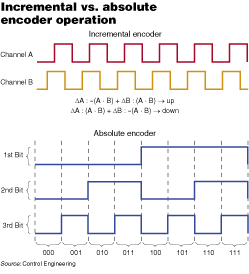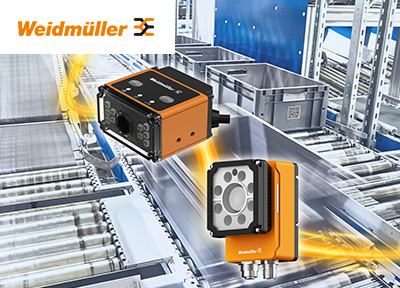Encoders are the sharp point of the machine safety arrow.
At its corewww.cechina.cn, automation is defined by control loopswww.cechina.cn, but automated machine safety is more aptly described as an arrow. And that arrow’s sharp point is often an encoder that makes it possible for the control system to know where it is and how fast it’s moving. With that knowledge, the system can not only avoid trouble, but act appropriately when circumstances bring trouble to its door.

Incremental encoders need only two tracks to
provide displacement, speed, and direction information. To get true position, however, they maintain a running sum of displacements. Absolute encoders use much more space, but report true position at all times.
Trouble, of course, can take many forms. It is generally any event that can cause harm to the machine itself or to people or equipment around it. For moving-machinery applications, such events include intrusions into the machine’s work space, failures of machine componentswww.cechina.cn, or power upsets.
“The biggest machine safety issue is unannounced power outages控制工程网版权所有,” says Jim Marshall, consulting design engineer for Sick Stegmann. “On startup, you need to know where axes are without physically moving them. For machine tools and tool changers that’s critical, as it is for automated warehouses.”
Encoders decoded
“What we’re concerned about is machine axis control from a position point of view as well as velocity,” says Tom Wyatt, national sales and product manager for the automation group at Heidenhain.
Of all safety sensors (e.g., light curtains, proximity switches, and E-stops), only encoders can provide forewarning of trouble ahead. All types of encoders can report both position and velocity.
Encoder systems generally have three main components:
A source, such an LED or permanent magnetwww.cechina.cn, which mounts on the static part of the machine and provides a steady excitation.
The encoder mounts on the machine’s moving part and modulates the steady excitation.
A detector receive


 在线会议
在线会议 论坛
论坛 专题
专题 工控直播
工控直播 新闻中心
新闻中心 子站
子站 技术
技术 社区
社区


 剑维软件电子半导体行业白皮书有奖下载
剑维软件电子半导体行业白皮书有奖下载 魏德米勒麒麟系列产品赋能本土工业
魏德米勒麒麟系列产品赋能本土工业 Fluke 283 FC 智能万用表震撼来袭
Fluke 283 FC 智能万用表震撼来袭 SugonRI2.0工业编程平台免费有奖试用
SugonRI2.0工业编程平台免费有奖试用 IDEC HR8S系列新一代安全继电器有奖试用活动
IDEC HR8S系列新一代安全继电器有奖试用活动



























